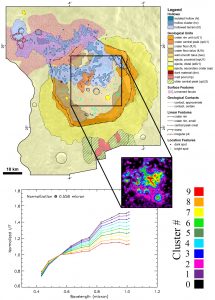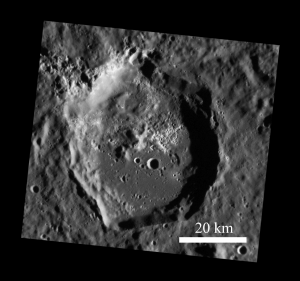18 September 2018
Mercury and its depressions
Posted by kcawdrey
Brilliant remains of the material left over from the devolatilization process on the surface of Mercury provide new information on the history of the formation of the first planet in the Solar System
Translated By Alice Lucchetti
One of the most surprising discoveries of the NASA’s Messenger mission was the presence of unusual, bright, irregular and rimless flat-floored depressions on the surface of Mercury. These depressions, called hollows, are usually found on crater walls, rims, floors and central peaks.
Since the hollows appear fresh, they may be actively forming today through a mechanism that could involve the loss of volatile compounds, but understanding how the hollows formed is still a major challenge for scientists.
In a new study published in Journal of Geophysical research: Planets, a journal of the American Geophysical Union, lead author Alice Lucchetti and her Italian team analyzed the nature of Mercury’s hollows inside three different impact craters: Dominici, Canova and Velazquez. The new study focuses understanding the geomorphology and compositional mineralogy of the hollows through the use of multi-color images acquired from the Mercury Dual Imaging System, or MDIS, instrument.
“We performed detailed geological mapping of the craters hosting hollows, making use of high- resolution images, in order to fully characterize the geological framework where these features formed.” Lucchetti said.

Comparison between the geological map and the spectral analysis for Canova crater. Hollows are identified by a well-defined spectrum (cluster #9). Credit: Lucchetti et al.
The researchers separated the craters’ areas into different units characterized by their spectral behavior. Comparing the results coming from the geomorphological and spectral analysis, we revealed a strong correlation between the spectral units and those identified in high-resolution geological maps,” Lucchetti said.
The new research shows the hollows in all three craters show a similar, well-defined, visible spectrum. When this spectrum is compared with laboratory spectra, it is indicative of a mixture of different materials.
“We found that both sulfides and pyroxene presenting transitional elements are responsible for the hollows absorption presented in the spectra,” Lucchetti said. “This provides new insights into the hollows’ nature and composition, suggesting that hollows terrains are the expression of not only the remnant material coming from a process that involve devolatilization, but also of the bedrock-forming material in which the hollows formed.”
This work is important to scientists’ overall understanding of the hollows.
“We are already studying other regions of Mercury to understand if it is a common behavior of these features or if different terrains affect their formation in different ways,” she said.
The hollows will also be one of the main targets of interest of the upcoming European Space Agency and Japan Aerospace Exploration Agency BepiColombo mission, which will be launched in mid-October.
–Alice Lucchetti is the first author of the new study. The article first appeared in Italian as a press release on the INAF website.



 GeoSpace is a blog on Earth and space science, managed by AGU’s Public Information staff. The blog features posts by AGU writers and guest contributors on all sorts of relevant science topics, but with a focus on new research and geo and space sciences-related stories that are currently in the news.
GeoSpace is a blog on Earth and space science, managed by AGU’s Public Information staff. The blog features posts by AGU writers and guest contributors on all sorts of relevant science topics, but with a focus on new research and geo and space sciences-related stories that are currently in the news.